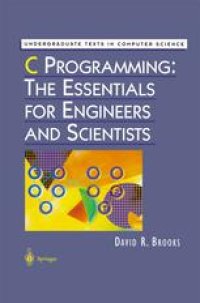
Ebook: C Programming: The Essentials for Engineers and Scientists
Author: David R. Brooks (auth.)
- Tags: Programming Languages Compilers Interpreters, Programming Techniques, Computer Graphics
- Series: Undergraduate Texts in Computer Science
- Year: 1999
- Publisher: Springer-Verlag New York
- Edition: 1
- Language: English
- pdf
1 The Purpose of This Text This text has been written in response to two trends that have gained considerable momentum over the past few years. The first is the decision by many undergraduate engineering and science departments to abandon the traditional programming course based on the aging Fortran 77 standard. This decision is not surprising, considering the more modem features found in languages such as Pascal and C. However, Pascal never developed a strong following in scientific computing, and its use is in decline. The new Fortran 90 standard defines a powerful, modem language, but this long-overdue redesign of Fortran has come too late to prevent many colleges and universities from switching to C. The acceptance of C by scientists and engineers is based perhaps as. much on their perceptions of C as an important language, which it certainly is, and on C programming experience as a highly marketable skill, as it is on the suitability of C for scientific computation. For whatever reason, C or its derivative C++ is now widely taught as the first and often only programming language for undergraduates in science and engineering. The second trend is the evolving nature of the undergraduate engineering curriculum. At a growing number of institutions, the traditional approach of stressing theory and mathematics fundamentals in the early undergraduate years, and postponing real engineering applications until later in the curriculum, has been turned upside down.
Today's scientist or engineer has many more computerized problem solving environments available than those of only a short time ago and so they are less dependant on mastering a scientific programming language such as FORTRAN. Many universities have made the switch to teaching the programming language C to science and engineering students, as it is still necessary in many fields to be able to produce one's own programs. This text teaches the essentials of C programming, concentrating on what the reader needs to know to produce working stand-alone programs to solve typical scientific and engineering problems. It is a learning-by-doing book with many examples and exercises and lays a foundation of scientific programming concepts and techniques that will prove valuable for those who might eventually move on to another language. The text is written for undergraduate students who are literate with a computer and typical applications but are new to programming.
Today's scientist or engineer has many more computerized problem solving environments available than those of only a short time ago and so they are less dependant on mastering a scientific programming language such as FORTRAN. Many universities have made the switch to teaching the programming language C to science and engineering students, as it is still necessary in many fields to be able to produce one's own programs. This text teaches the essentials of C programming, concentrating on what the reader needs to know to produce working stand-alone programs to solve typical scientific and engineering problems. It is a learning-by-doing book with many examples and exercises and lays a foundation of scientific programming concepts and techniques that will prove valuable for those who might eventually move on to another language. The text is written for undergraduate students who are literate with a computer and typical applications but are new to programming.
Content:
Front Matter....Pages i-xvii
Programming Preliminaries....Pages 1-22
The Basics of C Programming....Pages 23-69
Data Types, Operators, and Functions....Pages 71-119
Selection and Repetition Constructs....Pages 121-176
More About Modular Programming....Pages 177-231
Arrays....Pages 233-286
User-Defined Data Objects....Pages 287-312
Searching and Sorting Algorithms....Pages 313-354
Basic Statistics and Numerical Analysis....Pages 355-419
Binary Files, Random Access, and Dynamic Allocation....Pages 421-455
Back Matter....Pages 457-479
Today's scientist or engineer has many more computerized problem solving environments available than those of only a short time ago and so they are less dependant on mastering a scientific programming language such as FORTRAN. Many universities have made the switch to teaching the programming language C to science and engineering students, as it is still necessary in many fields to be able to produce one's own programs. This text teaches the essentials of C programming, concentrating on what the reader needs to know to produce working stand-alone programs to solve typical scientific and engineering problems. It is a learning-by-doing book with many examples and exercises and lays a foundation of scientific programming concepts and techniques that will prove valuable for those who might eventually move on to another language. The text is written for undergraduate students who are literate with a computer and typical applications but are new to programming.
Content:
Front Matter....Pages i-xvii
Programming Preliminaries....Pages 1-22
The Basics of C Programming....Pages 23-69
Data Types, Operators, and Functions....Pages 71-119
Selection and Repetition Constructs....Pages 121-176
More About Modular Programming....Pages 177-231
Arrays....Pages 233-286
User-Defined Data Objects....Pages 287-312
Searching and Sorting Algorithms....Pages 313-354
Basic Statistics and Numerical Analysis....Pages 355-419
Binary Files, Random Access, and Dynamic Allocation....Pages 421-455
Back Matter....Pages 457-479
....